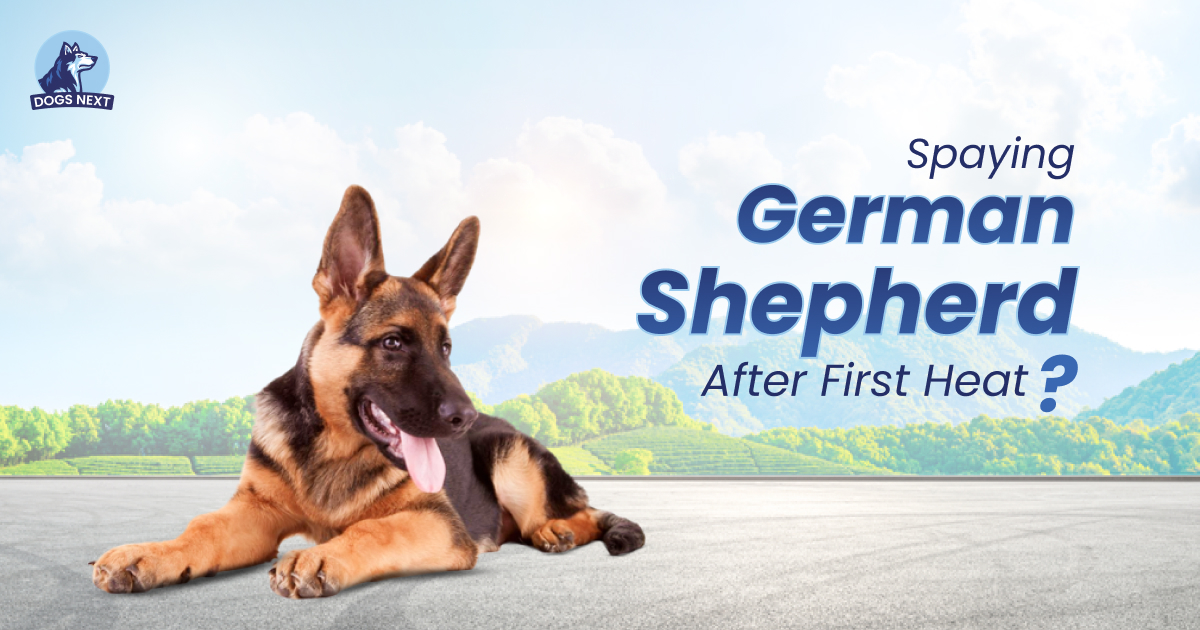Spaying your German Shepherd is a crucial decision that impacts her health and well-being. Spaying after her first heat can offer several benefits, such as reduced risks of mammary tumors and uterine infections. This timing allows her to mature physically but still provides protective health benefits.
Always consult with your veterinarian to determine the optimal time for spaying, considering her individual health and lifestyle. Proper planning and veterinary guidance ensure your German Shepherd leads a healthy and happy life. Taking this step can also help control the pet population and improve your dog’s quality of life.
Explanation Of The Canine Heat Cycle
Spaying a German Shepherd after her first heat is a crucial decision for many pet owners. Understanding the canine heat cycle can help in making an informed choice. This cycle is a natural part of a female dog’s reproductive system. Knowing its stages can guide you in deciding the best time for spaying.
Understanding The Heat Cycle
The canine heat cycle consists of four stages: proestrus, estrus, diestrus, and anestrus. Each phase has unique characteristics and symptoms.
Proestrus Stage
The proestrus stage lasts around 9 days. During this phase, you may notice swelling of the vulva and a bloody discharge. Your German Shepherd might also become more affectionate.
Estrus Stage
The estrus stage follows and lasts 5-13 days. This is the period when the female is receptive to males. The discharge changes to a straw color, and she might show signs of wanting to mate.
Diestrus Stage
The diestrus stage is the final active phase and lasts about 60-90 days. During this time, the female is no longer receptive to males. Hormone levels stabilize, and the body prepares for pregnancy or returns to normal.
Anestrus Stage
The anestrus stage is a rest period lasting around 4-5 months. No sexual activity occurs during this time. This stage allows the body to recover and prepare for the next cycle.
Signs Your German Shepherd Is In Heat
Importance Of Timing For Spaying
Spaying after the first heat can have health benefits. It reduces the risk of certain cancers and infections. It also helps in controlling the pet population.
Stages Of The Heat Cycle
Spaying your German Shepherd after her first heat is a crucial decision for her health and well-being. Understanding the stages of the heat cycle helps you make an informed choice. The heat cycle, also known as the estrous cycle, has distinct phases. Knowing these stages can help you care for your German Shepherd better.
Proestrus
The proestrus stage marks the beginning of the heat cycle. During this phase, your German Shepherd may have a swollen vulva and bloody discharge. This stage lasts about 7 to 10 days. Your dog may also become more affectionate or exhibit changes in behavior.
Estrus
In the estrus stage, your German Shepherd is fertile and ready to mate. The discharge may become lighter and more straw-colored. This stage usually lasts 5 to 14 days. You might notice your dog being more receptive to male dogs during this period.
Diestrus
The diestrus stage follows estrus and typically lasts around 60 to 90 days. During this time, your German Shepherd’s body either prepares for pregnancy or returns to normal if not mated. Hormonal changes occur, and you might see a decrease in swelling and discharge.
Anestrus
Anestrus is the final stage of the heat cycle, lasting about 4 to 5 months. This is a period of reproductive inactivity. Your dog will not show signs of heat during this phase. This stage allows her body to rest and recover before the next cycle.
| Stage | Duration | Key Characteristics |
| Proestrus | 7-10 days | Swollen vulva, bloody discharge, behavioral changes |
| Estrus | 5-14 days | Fertile period, lighter discharge, receptive to males |
| Diestrus | 60-90 days | Body prepares for pregnancy or returns to normal |
| Anestrus | 4-5 months | No signs of heat, reproductive inactivity |
Signs That Your Gsd Is In Heat
Spaying your German Shepherd after her first heat is a topic many dog owners consider. Understanding the signs that your GSD is in heat can help you make informed decisions. Recognizing these signs ensures you provide the best care during this period.
Physical Changes
When your German Shepherd is in heat, you will notice several physical changes. Her vulva will swell, and there may be a bloody discharge. This discharge can vary in color from bright red to a darker brown. You might also see her licking the area more frequently.
Behavioral Changes
Your GSD’s behavior will change too. She may become more affectionate or clingy. Some dogs might become restless or anxious. You might notice her marking territory more often or showing interest in male dogs.
Changes In Appetite
Heat cycles can affect your dog’s appetite. Some German Shepherds may eat less than usual. Others might experience an increase in appetite. Keep an eye on her food intake and ensure she stays healthy.
Frequent Urination
Another sign of heat is frequent urination. Your GSD might need to go outside more often. This is her way of signaling to male dogs that she is in heat.
Table: Key Signs Your Gsd Is In Heat
| Sign | Description |
| Swollen Vulva | Visible swelling around the vulva area. |
| Bloody Discharge | Bloody or brownish discharge from the vulva. |
| Behavioral Changes | Becoming more affectionate or anxious. |
| Appetite Changes | Increase or decrease in food intake. |
| Frequent Urination | Needing to urinate more often than usual. |
Benefits Of Spaying After The First Heat
Choosing to spay your German Shepherd after her first heat cycle offers numerous benefits. This decision impacts her health and behavior positively, ensuring a happier and healthier life. Below, we will explore the key advantages of this timing for spaying.
Health Benefits
Spaying your German Shepherd after her first heat significantly reduces the risk of mammary tumors. These tumors are common in unspayed females and can be life-threatening.
Additionally, it lowers the chance of uterine infections (pyometra). This condition requires emergency surgery and can be fatal if untreated. Spaying prevents this risk entirely.
Behavioral Improvements
After spaying, your German Shepherd’s behavior stabilizes. She will be less prone to mood swings and aggression caused by hormonal changes.
Spayed dogs are also less likely to roam in search of a mate. This reduces the risk of accidents and injuries from wandering.
Population Control
By spaying, you contribute to controlling the pet population. This reduces the number of unwanted puppies and helps shelters manage the animal population better.
Fewer stray dogs lead to fewer cases of neglected and abused animals, creating a better environment for all pets.
Cost Benefits
Spaying can save you money in the long run. Treating diseases like mammary tumors or pyometra can be expensive.
Preventive care through spaying is a one-time cost that can avoid hefty veterinary bills in the future.
Better Quality Of Life
Spayed German Shepherds often enjoy a better quality of life. They are less stressed and more focused on interacting with their family.
Overall, spayed dogs tend to live longer, healthier lives compared to their unspayed counterparts.
Timing Of Spaying: Why After The First Heat?
Spaying your German Shepherd is a significant decision for any dog owner. Timing is crucial, especially if you consider spaying after the first heat. Understanding the benefits and the right time to spay can ensure your furry friend’s health and well-being.
Why Spay After The First Heat?
Spaying after the first heat can offer numerous health benefits for your German Shepherd. One major advantage is the reduction in the risk of mammary tumors, which are common in unspayed females. Spaying at this time helps to balance hormonal changes, ensuring a healthier life for your pet.
Health Benefits Of Spaying
Spaying your German Shepherd after the first heat can lead to a longer, healthier life. It minimizes the risk of ovarian cancer and uterine infections. These conditions are common in unspayed females and can be life-threatening.
Here are some health benefits of spaying:
Behavioral Benefits
Behavioral issues often arise in unspayed female German Shepherds. Spaying can reduce aggression and irritability. Your dog may become more affectionate and easier to train.
Key behavioral benefits include:
Ideal Age For Spaying
The ideal age for spaying a German Shepherd is after the first heat, typically around 6 to 12 months old. This timing ensures that your dog benefits from the hormonal changes while reducing health risks.
Here is a table summarizing the ideal age for spaying:
| Age | Benefits |
| 6-12 months | Optimal health benefits and reduced risks |
Common Myths About Spaying
Many myths surround the spaying of German Shepherds. Some believe it causes weight gain or changes in personality. These myths are unfounded. Spaying does not lead to weight gain if you maintain a balanced diet and regular exercise for your dog.
Common myths include:
- Spaying causes weight gain
- Spaying changes the dog’s personality
It’s important to consult with your veterinarian to dispel any misconceptions and make an informed decision.
Preparing For The Spaying Procedure
Spaying your German Shepherd after her first heat can ensure her long-term health and well-being. Preparing for this procedure involves several steps to ensure a smooth experience for both you and your pet. From choosing the right time to preparing her for surgery, each step is crucial.
Choosing The Right Time
Deciding the best time to spay your German Shepherd is important. Most veterinarians recommend spaying after the first heat. This timing reduces the risk of certain cancers and other health issues.
Here are some factors to consider:
Consult your veterinarian to determine the best time. They will consider your dog’s health, size, and development.
Spaying after the first heat:
| Benefits | Details |
| Health | Reduces cancer risk |
| Behavior | May improve temperament |
| Population Control | Prevents unwanted puppies |
Pre-surgery Preparation
Preparing your German Shepherd for surgery is crucial. Proper preparation ensures a smooth procedure and recovery.
- Consult your vet: Schedule an appointment to discuss the spaying procedure.
- Health check: Ensure your dog is healthy and up-to-date on vaccinations.
- Fasting: Your dog should fast for 12 hours before the surgery.
- Comfort: Provide a comfortable space for recovery post-surgery.
- Ensure vaccinations are up-to-date.
- Follow fasting instructions from your vet.
- Prepare a quiet, comfortable space for recovery.
- Stock up on necessary supplies like pain medications and soft bedding.
| Task | Details |
| Consult Vet | Discuss procedure and recovery |
| Health Check | Ensure dog is healthy |
| Fasting | 12 hours before surgery |
| Comfort | Prepare recovery space |
Following these steps will help ensure your German Shepherd is ready for the spaying procedure.
The Spaying Procedure
Spaying your German Shepherd after her first heat is a crucial step for her health and well-being. The spaying procedure involves removing the ovaries and uterus, which prevents future heat cycles and unwanted pregnancies. This procedure not only helps control the pet population but also offers several health benefits for your beloved pet.
The Spaying Procedure: What To Expect
The spaying procedure for your German Shepherd is a common and generally safe surgery. It usually takes place at a veterinary clinic.
First, the vet will perform a thorough check-up to ensure your dog is healthy enough for surgery. This includes a physical examination and blood tests.
Preparing Your Dog For Surgery
Before the surgery, your dog must fast for 12 hours. This helps prevent any complications during anesthesia.
Ensure your dog is calm and comfortable. Bring her favorite blanket or toy to the clinic to help ease her anxiety.
The Surgical Process
During the surgery, your dog will be under general anesthesia. This means she will be unconscious and feel no pain.
The vet makes a small incision in the abdomen. Through this incision, they remove the ovaries and uterus.
After the organs are removed, the vet will close the incision with sutures or staples. The entire procedure usually takes about 45 minutes to an hour.
After surgery, your dog will need to rest and recover. The vet will provide pain medication to keep her comfortable.
Limit her activity for at least 10-14 days. Ensure she doesn’t lick or bite the incision site, which can cause infections.
Follow the vet’s instructions for a smooth recovery. Keep the incision clean and dry, and monitor for any signs of complications.
| Steps | Details |
| Pre-Surgery Check-Up | Physical exam and blood tests |
| Fasting | 12 hours before surgery |
| Anesthesia | General anesthesia to ensure no pain |
| Incision | Small cut in the abdomen |
| Organ Removal | Ovaries and uterus are removed |
| Closure | Sutures or staples to close the incision |
| Recovery | Pain management and limited activity |
Post-surgery Care
Spaying your German Shepherd after her first heat is a significant step in her health. Post-surgery care is crucial for her recovery and well-being. This care includes immediate attention right after the surgery and long-term care to ensure she stays healthy.
Immediate Aftercare
After the surgery, your German Shepherd will need special attention. Monitor her closely for the first 24 hours. This is when she is most vulnerable.Here are some important tips for immediate aftercare:
Here’s a quick reference table for immediate aftercare:
| Task | Frequency |
| Monitor incision | Daily |
| Administer medication | As prescribed |
| Limit activity | Constantly |
| Offer food and water | Small, frequent meals |
Long-term Care
Once she has recovered from the initial surgery, long-term care becomes essential. This ensures she remains healthy and active.
Here are some key aspects of long-term care:
- Regular Vet Check-ups: Schedule routine vet visits to monitor her health and catch any issues early.
- Balanced Diet: Feed her a nutritious diet to maintain her weight and overall health. Consult your vet for recommendations.
- Exercise: Provide regular exercise to keep her fit and happy. Avoid high-impact activities until she is fully healed.
- Monitor Behavior: Watch for any changes in behavior, which could indicate health issues.
- Dental Care: Brush her teeth regularly to prevent dental problems.
Incorporate these tips into her daily routine. Consistency is key in maintaining her health and well-being.
Behavioral Changes After Spaying
Spaying your German Shepherd after her first heat can bring about noticeable changes in her behavior. Understanding these changes helps you better care for your furry friend. This section dives into the specific behavioral changes you might observe.
1. Reduced Aggression
After spaying, many German Shepherds show a decrease in aggressive behavior. They become more relaxed and less territorial. This change makes them easier to manage and more pleasant to be around.
2. Less Roaming
Spayed dogs often exhibit less desire to roam. They are less likely to escape from your yard or run away. This behavior keeps them safer and reduces the risk of accidents.
3. Calmer Demeanor
German Shepherds tend to have a calmer demeanor post-surgery. They are less likely to engage in hyperactive behaviors. This calmness can make training and daily interactions more enjoyable.
4. Decreased Marking
After spaying, you may notice a reduction in marking behaviors. Female dogs are less likely to urinate around your home to mark their territory. This change can make housecleaning much easier.
5. Consistency in Mood
Spaying helps in achieving more consistent moods. Hormonal fluctuations no longer affect your dog’s behavior. This stability makes her more predictable and easier to live with.
6. Improved Focus
Post-spay, many German Shepherds exhibit improved focus and attention. They are less distracted by other animals. This improvement can enhance training sessions and daily activities.
7. Better Social Behavior
Spayed dogs often show better social behavior with other pets and humans. They are less likely to engage in dominance struggles. This behavior makes them more sociable and friendly.
Addressing Common Concerns
Spaying your German Shepherd after her first heat can be a daunting decision. Many pet owners have concerns about the timing, health implications, and behavioral changes. This section aims to address common concerns and provide clarity on this important topic.
Health Implications
Spaying a German Shepherd after her first heat can reduce the risk of certain cancers and infections. Mammary gland tumors are less likely to develop. Uterine infections, known as pyometra, are also less common in spayed dogs.
Weight gain is a common concern. Proper diet and regular exercise can help maintain a healthy weight. Monitoring her food intake and activity levels is key to preventing obesity.
Behavioral Changes
Many owners worry about behavioral changes after spaying. Some dogs may become calmer and less aggressive. Spaying can reduce roaming and marking behaviors. Your German Shepherd may be more focused and obedient.
Personality changes are rare. Most dogs retain their playful and loving nature. Training and socialization play a significant role in your dog’s behavior.
Cost Considerations
| Service | Cost Range |
| Spaying Surgery | $150 – $500 |
| Post-Surgery Medications | $20 – $50 |
| Follow-Up Visits | $30 – $100 |
Spaying costs can vary based on your location and the veterinary clinic. Some clinics offer payment plans or discounts. Check with local animal shelters for low-cost options.
Recovery Time
Your German Shepherd will need time to recover after spaying. Most dogs recover within 10-14 days. During this period, limit her activity to prevent complications. Keep the incision site clean and dry to avoid infections.
Monitor her behavior for any signs of discomfort or unusual behavior. Contact your vet if you notice any issues.
When To Seek Veterinary Help
Spaying your German Shepherd after her first heat can be a critical decision. It’s vital to recognize when to seek veterinary help. Timely intervention ensures your dog’s safety and well-being. Below are signs and situations where professional advice is necessary.
Excessive Bleeding
Excessive bleeding during or after the heat cycle is a red flag. This could indicate an underlying health issue. Consult your vet immediately if you notice more blood than usual.
Abnormal Behavior
Watch for signs like lethargy, aggression, or unusual shyness. These behaviors may signal a problem. A vet’s evaluation helps determine the cause and provide treatment.
Swollen Abdomen
A swollen or distended abdomen could indicate complications. This might include infections or internal bleeding. Seek veterinary help promptly to avoid serious issues.
Persistent Vomiting Or Diarrhea
Ongoing vomiting or diarrhea after the heat cycle is concerning. These symptoms can lead to dehydration. Contact your vet for a thorough examination and treatment plan.
Appetite Loss
Refusal to eat or drink for an extended period is alarming. Appetite loss may suggest an underlying health problem. Veterinary attention is crucial to address any potential issues.
| Symptom | Action |
| Excessive Bleeding | Consult Vet Immediately |
| Abnormal Behavior | Vet’s Evaluation |
| Swollen Abdomen | Seek Prompt Help |
| Persistent Vomiting/Diarrhea | Contact Vet |
| Appetite Loss | Veterinary Attention |
Frequently Asked Questions
When To Spay A German Shepherd?
It’s recommended to spay a German Shepherd after her first heat. This timing helps in preventing health issues and unwanted pregnancies.
Benefits Of Spaying After First Heat?
Spaying after the first heat reduces the risk of mammary tumors. It also prevents uterine infections and unwanted litters.
Risks Of Early Spaying?
Early spaying can increase the risk of certain health issues. These include joint problems and urinary incontinence.
How Does Spaying Affect Behavior?
Spaying generally reduces aggression and roaming behavior. It also helps in reducing the risk of hormone-driven behaviors.
Conclusion
Spaying your German Shepherd after the first heat offers many benefits. It helps prevent health issues and unwanted pregnancies. Remember to consult your vet for the best timing. Taking this step ensures your dog’s long-term well-being and happiness. Prioritize your pet’s health by making informed decisions.

I’m David, an expert contributor and writer, with two furry friends of my own, I know the challenges of raising and caring for dogs. From training to nutrition and health, my goal is to provide valuable insights and advice to help create strong bonds and happy, healthy lives. Find me in Twitter.




